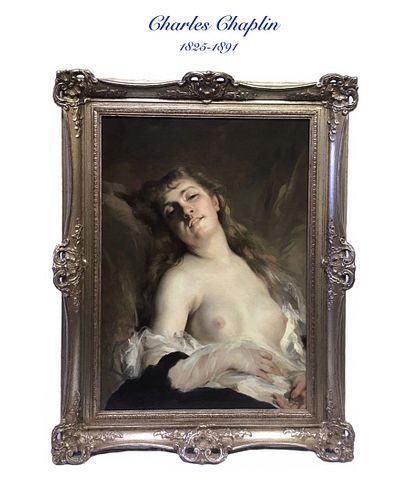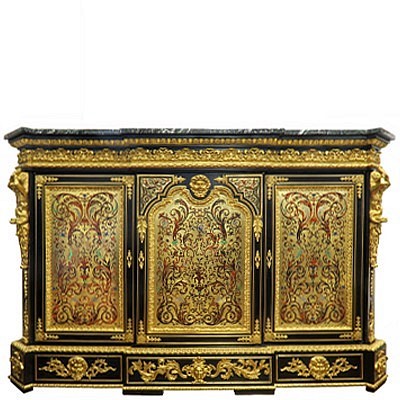19th C. French Oil on Canvas By Charles Chaplin
About Seller
1260 S Central Ave
Glendale, CA 91204-2596
United States
Antique Kingdom Inc. is established in Orange County, California and serves a myriad of online art lovers, with utmost respect, unfailing transparency and limitless passion. A true enchantment for your artistic senses in the purest form, with an endless, immeasurable bounty of authentic historic bro...Read more
Two ways to bid:
- Leave a max absentee bid and the platform will bid on your behalf up to your maximum bid during the live auction.
- Bid live during the auction and your bids will be submitted real-time to the auctioneer.
Bid Increments
| Price | Bid Increment |
|---|---|
| $0 | $50 |
| $300 | $100 |
| $1,000 | $250 |
| $5,000 | $500 |
| $10,000 | $1,000 |
| $50,000 | $2,500 |
| $100,000 | $5,000 |
| $200,000 | $7,500 |
| $500,000 | $10,000 |
| $1,000,000 | $25,000 |
About Auction
Mar 25, 2021
Antique Kingdom has a great collection includes 19th century European antiques especially French fine arts items, Persian Rugs, Asian Artworks and even more from world wide antiques and arts! Antique Kingdom Inc. antiquekingdom1@gmail.com
- Lot Description
19th C. French Oil on Canvas Painting by Charles Chaplin. Frame: D 36" x 27", Painting: D 28.1/2" x 19.3/4". About Artist: Charles Joshua Chaplin (8 June 1825 - 30 January 1891) was a French painter and print-maker who painted both landscapes and portraits. He worked in techniques such as pastels, lithography, watercolor, chalk, oil painting and etching. He was best known for his elegant portraits of young women. Charles Joshua Chaplin was born on 8 June 1825 in Les Andelys, Eure, France. His mother, Olympia Adelle Moisy, was French, whereas his father, John Chaplin, was an art broker from England. Charles Chaplin spent his whole life in France, becoming a naturalized citizen in 1886. He studied at the Ecole des Beaux-Arts in Paris from 1840, and he took private lessons in the studio of Michel Martin Drolling, whose apprentices included Paul Baudry, Jules Breton and Jean-Jacques Henner. Later he also taught at the cole des Beaux-Arts. In 1845, he entered the Paris Salon, the official art exhibition of the Academie des Beaux-Arts, as a portrait and landscape painter with the painting Portrait of the Artist's Mother. Chaplin conducted art classes specifically for women at his studio, including Marie Josephine Nicolas. The American artist Mary Cassatt, the French artist Louise Abbema and the English artist Louise Jopling were among Chaplin's students. His son Arthur Chaplin was also a painter. Chaplin died on 30 January 1891 in, aged 65, Paris as a wealthy man and is buried in the Pare Lachaise Cemetery. Gradually the muddy colours used by Chaplin transformed into white, grey and pink, depicting his models with an opalescent, mother-of-pearl complexion by applying a subtle palette of rosy flesh tones and light greys. After painting portraits and trying his skills on ornamental painting, Chaplin took up genre painting in the 1850s. His favourite subjects are the feminine grace of a young woman everyday life. He portrays women in several poses: resting; grooming; singing; and reading. He captures them with lightness and carelessness and accentuates the decorative elements of the composition. Empress Eugenie, the wife of Napoleon III and an admirer of the "Pompadour style", rapidly fell under the enchantment of the painter's neo-Rococo works. Chaplin was among Napoleon III and Empress Eugenie's favourite court artists. In 1859, when his portrait of Aurora was banned by the judges of the Salon as "too erotically suggestive", Napoleon III defended Chaplin and overturned the disqualification order.[8] He was similarly valued as an interior decorator and was appointed to remodel the decor of Empress Eugenie's rooms. His sensual portraits of women and young girls, often with models posed erotically in hazy surroundings and frequently wearing transparent clothing, attracted the interest of the high society and aristocracy of Paris during the French Third Republic (1870 - 1940) guaranteeing his success and wealth. He was one of the most popular painters of his time, but nowadays his work is almost unknown, in spite of the fact that his works hang in many major museums around the world. He employed his Rococo style for his mythological scenes and genre scenes paintings. His genre pictures formed a significant part of his work. In 1861, working as a decorative painter. Chaplin painted the doors and several glass panels above them of the Salon des Fleurs in the Tuileries Palace. The Palace was gutted by fire in 1871 and its ruins swiftly demolished. He also undertook decorating work in the Salon de l'Hemicycle of the Palais de l'Elysee. As a member of the Academie royale de peinture et de sculpture, Chaplin exhibited his paintings at the Paris Salon, the official exhibition venue of members' work. He began exhibiting his paintings at the French Artists' Salon in 1845 and was represented there habitually each year. These exhibitions made him one of France's most famous portrait artists. Commencing in 1847, his work was exhibited regularly at the Royal Academy in London. During his lifetime, he received acclamation for his artistic talents by the award of several medals: a third class medal in 1851; a second class medal the following year; and an Honour Medal in 1865. He was declared Chevalier de la Legion d'Honneur in 1879, also known as The National Order of the Legion of Honour. Chaplin was elevated to Officier in 1881. Chaplin's artistic talent was admired by renowned writers, painters and critics such as Arsene Houssaye, Emile Zola and Theophile Gautier. Edouard Manet felt Chaplin knew "the smile of a woman". It was his portraits of young women that gained him particular success. His works can be viewed in the French museums of Bordeaux, Bayonne, Bourges, Mulhouse, Paris, Reims, Rouen, Saintes, Charente-Maritime, and the Louvre Museum Graphic Art Database. Outside France his works can be found in the Hermitage Museum, Saint Petersburg, at the Metropolitan Museum of Art, the Harvard Art Museums in Massachusetts and the Indianapolis Museum of Art in Indiana. Chaplin has several paintings in a public collection in the United Kingdom at the Bowes Museum. One of Chaplin's paintings was sold at an auction in Paris on 5 June 1922. Described by the auctioneer as a landscape painting by Charles Chaplin, it achieved an unexpectedly high price for an artist considered to have "fallen into oblivion". Most of the bidders mistakenly believed it was a work of art by the comedian and actor Charlie Chaplin and thought they would acquire a remarkable find. The New York Times reported it stating: The disappointment of the ultimate buyer may be imagined when it was discovered that the picture was by an almost forgotten artist.
- Shipping Info
-
Bidder is responsible for all shipping costs. We recommend "Ship 1" Tel: 714-975-1342, ship1info@gmail.com or "Box n Ship" at 626-793-1607, Boxnship-pasadena@sbcglobal.net, We are not responsible for any damage in shipping, we suggest you purchase insurance.
-
- Payment & Auction Policies
-
Available payment options
For Payment, We do accept Credit Cards by click on "MAKE A PAYMENT" in your invoice page or Cashier's checks, personal checks and Bank Wire Transfers. - If you wish to send a Personal Check or Cashier's Check: Please make Payable to: Antique Kingdom. - Send to: 1260 S Central Ave, Glendale, CA 91204. -- If you wish to use a Bank Wire Transfer: ( recommended for faster shipping ). Our Bank information is as follows. Wire to: Antique Kingdom. Bank Name: CalPrivate Bank Acct #: 501581. ABA# Routing #: 122244029. For International: Swift # CLPVUS66 XXX, Bank address: 9606 S. Santa Monica Blvd, 3rd floor, Beverly Hills, CA 90210. We will notify you as soon as payment has cleared our bank. You may then directly arrange your shipping. We will assist and supply Contact Info for possible Shippers. Note: Antique Kingdom will NOT ACCEPT credit card payments on such items as Watches & Jewelry!
-
-
- Buyer's Premium



 EUR
EUR CAD
CAD AUD
AUD GBP
GBP MXN
MXN HKD
HKD CNY
CNY MYR
MYR SEK
SEK SGD
SGD CHF
CHF THB
THB














